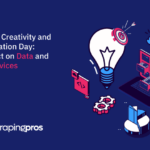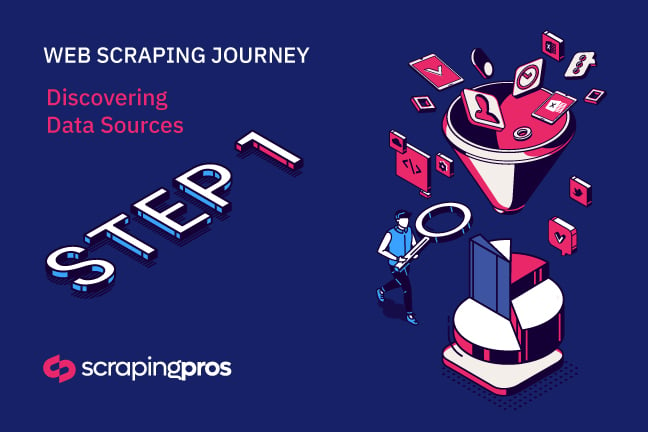In today’s digital age, information is the key to making intelligent decisions in both the personal and business spheres. However, finding and organizing data on the Internet can be overwhelming. That’s where web scraping comes into play. It is a useful technique that helps us collect and organize information online for various purposes. In a series of simple, easy-to-follow posts, we’ll take you on a journey through the web scraping process, starting with why it’s important, helping you choose the right sources of data, showing you how to extract and organize that data, and finally how to use them effectively. Join us as we unlock the world of web scraping, allowing you to discover valuable data online and put it to good use.
Identifying The Data Sources
When identifying where to extract the data to scrape, it is advisable to evaluate in detail different parameters related to the websites with which we are going to work. At this point, we will take into account seven main criteria:
- Relevance: It is important to ensure that the web pages we are going to scrape provide reliable content that we can benefit from. The data we extract from the web will be only as good as the sources from which we track it. Great care should be taken to find quality websites, where reliable data can be found as we begin our exploration. For example, in general, websites that offer a clean, simple design and user experience tend to be valuable sources of information. On the other hand, websites with cluttered and bad user interfaces often contain low-quality information.
- Update: The data you acquire must be recent and relevant to the current period to be of any use. If the sources you choose have old, outdated data available, you are putting your business analysis at risk by getting irrelevant results that don’t fit the current period. You should always look for websites that are regularly updated with new and relevant data to include as scraping sources. If the dates are not displayed on the site, you can always drill down into the source code to find the last modified date of the HTML document.
- Accessibility: First of all, we must avoid sites that discourage bots, because although it is technically feasible to track and extract data from sites that block automated bots through IP blocking or similar technologies, it is not recommended to include such websites in your list. In addition to the associated legal risk, a site that discourages automated scraping runs the risk of losing data when this site implements better-blocking mechanisms in the future. Secondly, we should not choose sites with too many broken links. A website with too many broken links is a poor choice as a source of web scraping (a clear indicator of negligence on the part of the website administrator). A web scraping setup will also stop when it finds a broken link. These problems would be catastrophic for your web scraping plan, due to the low quality of the data obtained and the accessibility problems it entails.
- Behavioral Differences: Websites can also behave differently. Some may require user interactions such as clicking buttons, filling out forms, or handling CAPTCHAs to access the desired data. Understanding these behavioral aspects is essential to successfully scrape data.
- Robustness and Reliability: Web scraping scripts need to be robust and reliable. This means handling various scenarios like handling errors, retries, and timeouts gracefully. Customizing the code to deal with specific situations unique to each website is necessary for dependable scraping.
- Positioning: Recently search engines have become smarter when it comes to identifying useful websites for your business. Google’s changing algorithms have almost succeeded in removing bad, spammy websites from the top of search engine results pages. This would mean that it is important to use a site’s search engine rankings to get an idea of how authoritative it is in its niche and how it ranks high in search results. If a site does not appear anywhere in the search results, this could imply a negative reputation that directly affects the credibility of the website and the data it hosts. However, for all the above, this should not be the only reason to reject a site as a source of web scraping.
- Legal and Ethical Considerations: Customization also involves respecting the website’s terms of service and legal constraints. Some websites may explicitly prohibit scraping in their terms, and web scrapers must adhere to these rules to avoid legal issues.
Our Web Scraping Process
Scraping Pros meets the best quality standards and benchmarks on the market. Our experience and track record in providing Web Scraping solutions make us the safest and most reliable choice to face this process.
To customize web scraping for a specific website relevant to your business, we follow the following steps:
- Studying the Website Structure and Behavior: Analyze the website’s HTML structure to identify the location of the desired data. Examine how the website loads content, especially if it relies on JavaScript or AJAX requests
- Writing the Code: Based on the analysis, write code that accesses the website’s HTML or interacts with it programmatically. Utilize appropriate libraries and tools, such as Beautiful Soup, Selenium, or Puppeteer, depending on the specific needs and challenges of the website.
- Testing and Refinement: Thoroughly test the code against the target website to ensure that it can consistently extract the desired data. Monitor the code’s performance and make refinements as necessary, addressing any issues that may arise during scraping. Handle exceptions and edge cases to prevent data extraction failures.
In conclusion
In summary, web scraping is a highly customized process for each website due to the unique characteristics and challenges presented by different sites. Customization involves studying the website’s structure and behavior, writing code tailored to those specifics, and rigorously testing and refining the code to ensure accurate and reliable data extraction. Additionally, it’s essential to adhere to legal and ethical considerations to maintain the integrity of web scraping practices
This entire process allows us to recover and extract the client’s desired data, from the sites chosen as the main target, and achieve it systematically and efficiently. It should be noted that all our practices are legal, ethical, and supported by compliance regulations regarding public data.






